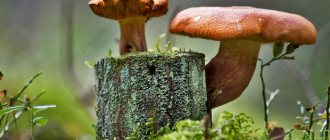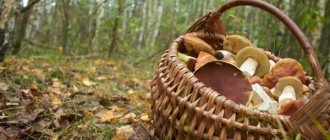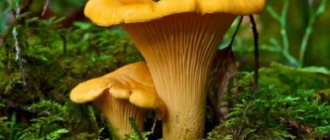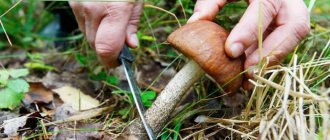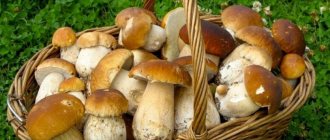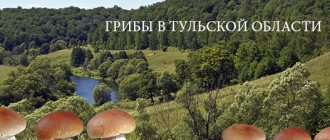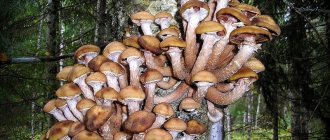Picking mushrooms and berries
In the draft of the new edition of the Code of Administrative Offences, it is proposed to increase the fine for the destruction of rare animals, plants and mushrooms by 20 times, that is, for individuals it will be 100,000 rubles. draft of the new administrative code can be found at this link, where you can vote for its adoption or propose changes. In 2022, the old Code of Administrative Offenses is in force, where the fine for the destruction of rare mushrooms is 5,000 rubles.
Reference Information:
Rare mushrooms of the Moscow region
Otherwise, the following rules apply to mushroom pickers and berry pickers:
The rules for harvesting forest resources are regulated by order of the Federal Forestry Agency dated December 5, 2011 N 511, “On approval of the Rules for harvesting food forest resources and collecting medicinal plants.”
This order does not apply to citizens engaged in collecting forest resources for their own needs (Clause 1 of the General Provisions), however, unscrupulous officials and owners of forest plots may begin to refer to it, try to prohibit you from collecting mushrooms and berries on their territory and try to fine you .
The fine for violating the rules is 200-500 rubles (Article 8.25 of the Code of Administrative Offenses of the Russian Federation).
In the new draft Code of Administrative Offenses (Article 17.18.), the fine has not changed.
Recently, many media outlets reported news about a ban on collecting birch sap, restrictions on collecting mushrooms based on the size of the cap, etc. Having examined the regulations that the media referred to, we found out the following:
This information is based on the order of the Ministry of Nature “On approval of rules for the procurement of food forest resources and collection of medicinal plants” dated July 28, 2020 No. 494, which was issued and entered into force on January 1, 2022, which can be found on the legal information portal.
It says:
Clause 1 General provisions of the Order:
These Rules for the procurement of food forest resources and the collection of medicinal plants (hereinafter referred to as the Rules) were developed in accordance with Article 34 of the Forest Code of the Russian Federation and regulate the relations arising during the procurement of food forest resources and the collection of medicinal plants, with the exception of the procurement and collection of these types of resources for one’s own needs of citizens .
As we can see, it contains the phrase: with the exception of the procurement and collection of these types of resources for citizens’ own needs , that is, this order regulates only business activities and does not concern ordinary citizens.
If we look at Article 34 of the Forest Code, it applies to citizens who are engaged in entrepreneurial activities and this order was issued to implement paragraph 5 of this article and regulates the procedure and rules for this activity.
The rights and obligations of citizens are spelled out in Article 11 of the Forest Code and have not changed.
What are the signs of mushroom poisoning?
https://www.youtube.com/watch?v=ytadvertiseru
The first symptoms are nausea, vomiting, diarrhea. If you or your loved ones experience these signs after eating mushrooms, you should consult a doctor immediately. Acute mushroom poisoning is much more severe than other food poisonings.
Having called a doctor, you should give the patient first aid: rinse the stomach with clean cold water (without potassium permanganate), give activated charcoal and force him to drink as much liquid as possible: this will prevent dehydration.
Making fires in the forest
According to the Decree of the Government of the Russian Federation dated June 30, 2007 N 417 (as amended on April 17, 2019) “On approval of Fire Safety Rules in Forests,” the following is prohibited in the Russian Federation:
- make fires in coniferous forests, peat bogs and other fire-hazardous places;
- refuel the car with the engine running;
- throw lighted matches, cigarette butts;
A fire is allowed only on areas outside coniferous forests separated by a strip of land 0.5 meters wide (in the photo). It is allowed to make fires in rainy autumn and winter.
The fine for violating these rules ranges from 1,500 to 3,000 rubles. (Article 8.32 of the Code of Administrative Offenses of the Russian Federation).
In the new draft Code of Administrative Offenses (Article 17.21, the fine has not changed)
Use tourist gas burners in the forest, it is more convenient, comfortable and safe, check out the review of the burner from Ali Express, it is ideal for going to the forest to pick mushrooms.
How to distinguish an edible mushroom from an inedible one?
If this is your first time going for mushrooms, try to find yourself an experienced companion. Before going, either on the Internet (for example, here) or in specialized literature, study photographs of inedible mushrooms. In Belarus, these are, first of all, pale toadstool, fly agaric, fiber mushroom, gall mushroom, pepper mushroom, false honey fungus and false chanterelle.
It is necessary to pay attention to the shape of the mushroom, external color, color and smell of the pulp before and after cutting, and follow the collection rules. If the pale toadstool was cut off at the upper third of the stem, closer to the cap, then the well-known signs of its poisonousness remain unnoticed: the corolla on the stem and the sac-like formation at the base.
https://www.youtube.com/watch?v=ytdevru
The basic rule of a mushroom picker is: “If you’re not sure, don’t take it!” If you doubt that a mushroom is edible, do not touch it. It's better to return home with a half-empty bucket than to get seriously poisoned.
Staying in the forest during a fire danger period
According to the Fire Safety Rules in Forests, during a fire hazardous period, the Ministry of Emergency Situations or the local administration may impose a ban on citizens visiting forest areas ; unfortunately, it can easily coincide with the mushroom and berry picking season. Check this before visiting the forest. You can find out on the website of the Government, Administration, Ministry of Emergency Situations and other executive authorities.
The fine for violation ranges from 4000 - 5000 rubles (Article 8.32 of the Code of Administrative Offenses of the Russian Federation)
Mushroom picker calendar - summary table for the entire mushroom season
| What mushrooms to collect | When to pick mushrooms | ||||||
| April | May | June | July | August | September | October | |
| Morels | + | + | + | — | — | — | — |
| Stitches | + | + | + | — | — | — | — |
| May mushroom | — | + | + | — | — | — | — |
| Oyster mushroom | — | + | + | + | + | + | + |
| Meadow honey fungus | — | — | + | + | + | + | — |
| boletus | — | — | + | + | + | + | — |
| Oiler grainy | — | — | — | + | + | + | — |
| Summer honey fungus | — | — | + | + | + | + | + |
| The fox is real | — | — | — | + | + | + | — |
| Porcini | — | — | + | + | + | + | + |
| Boletus | — | — | + | + | + | + | + |
| Pluteus deer | — | — | + | + | + | + | + |
| Spiky raincoat | — | + | + | + | + | + | + |
| Common champignon | — | — | + | + | + | + | — |
| Field champignon | — | — | — | — | + | + | — |
| Valuy | — | — | — | + | + | + | — |
| Funnel talker | — | — | — | + | + | + | — |
| White umbrella mushroom | — | — | — | + | + | + | — |
| Variegated umbrella mushroom | — | — | — | + | + | + | + |
| Real milk mushroom | — | — | — | — | + | + | — |
| Poddubovik | — | — | — | + | + | + | — |
| Ivyshen | — | — | — | — | + | + | + |
| Loader white | — | — | — | — | + | + | — |
| Loader black | — | — | — | — | + | + | — |
| Fat pig | — | — | — | — | + | + | — |
| Yellow russula, food grade, etc. | — | + | + | + | + | + | — |
| Green moss | — | — | + | + | + | + | + |
| Yellow hedgehog | — | — | — | — | + | + | — |
| Ringed cap | — | — | — | + | + | + | — |
| Larch oiler | — | — | — | + | + | + | — |
| Volnushka pink | — | — | — | — | + | + | + |
| Black breast | — | — | — | + | + | + | + |
| Spruce green camelina | — | — | — | — | + | + | + |
| Pine mushroom | — | — | — | — | + | + | + |
| Gray talker | — | — | — | — | + | + | — |
| Late oiler | — | — | — | — | + | + | — |
| Winter mushroom | — | — | — | — | — | + | + |
| Loader black and white | — | — | — | — | — | + | + |
| Polish mushroom | — | — | — | — | + | — | — |
| Autumn oyster mushroom | — | — | — | — | — | + | — |
| Gray row | — | — | — | — | — | + | — |
| Autumn stitch | — | — | — | — | — | + | + |
| Autumn honey fungus | — | — | — | — | — | + | + |
| Row purple | — | — | — | — | + | + | — |
| Greenfinch | — | — | — | — | + | + | + |
| Hygrophor brown | — | — | — | — | — | + | + |
| Types of mushrooms | May | June | July | August | September | October | ||||||||||||
| Decades | ||||||||||||||||||
| I | II | III | I | II | III | I | II | III | I | II | III | I | II | III | I | II | III | |
| Morel | ||||||||||||||||||
| Porcini | ||||||||||||||||||
| Boletus | ||||||||||||||||||
| boletus | ||||||||||||||||||
| Chanterelle | ||||||||||||||||||
| Oiler | ||||||||||||||||||
| Mosswort | ||||||||||||||||||
| Honey fungus | ||||||||||||||||||
| Ryzhik | ||||||||||||||||||
| Volnushka | ||||||||||||||||||
| Gruzd | ||||||||||||||||||
| Valuy | ||||||||||||||||||
| Russula | ||||||||||||||||||
| Champignon | ||||||||||||||||||
| Belyanka (white volnushka) | ||||||||||||||||||
| Gorkushka | ||||||||||||||||||
| Greenfinch | ||||||||||||||||||
| Serushka | ||||||||||||||||||
| Kozlyak | ||||||||||||||||||
| Raincoat | ||||||||||||||||||
| Cap | ||||||||||||||||||
| Ryadovka | ||||||||||||||||||
| Violin | ||||||||||||||||||
| Mushroom picker calendar for the entire mushroom season | ||
| When to pick mushrooms | What mushrooms to collect | Where to pick mushrooms |
| March | Oyster mushroom, tree mushrooms, talker | There are practically no mushrooms, but at the end of the month the first snowdrops may appear. If the winter is warm, you can find fresh oyster mushrooms. Oyster mushrooms usually grow on trees, the cap of such a mushroom is one-sided or rounded, the plates run down to the stem, as if growing to it. It is not difficult to distinguish oyster mushrooms from inedible mushrooms - it has a cap that is completely leathery to the touch. |
| April | Oyster mushroom, tree mushrooms, govorushka, morel, stitch | Snowdrop mushrooms – morels and stitches – are quite common |
| May | Morel, stitch, oil can, oyster mushroom, raincoat | Most mushrooms can be found not under trees, but in clearings, in thick grass. |
| June | Oiler, boletus, boletus, oyster mushroom, morel, honey fungus, chanterelle, porcini mushroom, puffball | In June, mushrooms of the highest (first) category begin to appear. |
| July | Oiler, boletus, boletus, oyster mushroom, morel, puffball, honey fungus, chanterelle, porcini mushroom, moss mushroom | There are already quite a lot of mushrooms - both in the clearings and under the trees. In addition to mushrooms, strawberries and blueberries are already found. |
| August | Oiler, boletus, boletus, oyster mushroom, morel, honey fungus, chanterelle, porcini mushroom, moss mushroom | At this time, mushrooms can be found almost everywhere: in the grass, under trees, near stumps, in ditches and on trees, and even in city squares and on the sides of roads. In addition to mushrooms, lingonberries have already ripened, and cranberries are appearing in the swamps. |
| September | Oiler, boletus, boletus, oyster mushroom, morel, honey mushroom, chanterelle, porcini mushroom, moss mushroom, | September is the most productive month for mushrooms. But you need to be careful: autumn is coming to the forests, and in the bright foliage it is difficult to see the multi-colored mushroom caps. |
| October | Valuy, oyster mushroom, camelina, honey fungus, champignon, boletus, porcini mushroom, milk mushroom, moss mushroom, russula | The number of mushrooms in the clearings begins to decrease. In October, it is better to look for mushrooms near stumps and under trees. |
| November | Butterfly, greenfinch, oyster mushroom, tree mushrooms. | Frosts are beginning, but there is a high probability of finding frozen mushrooms. |
Parking and car parking in the water protection zone
Parking in the water protection zone is prohibited by Article 65 of the Water Code of the Russian Federation. It would seem that what mushroom pickers have to do with it, only fishermen should worry, but the problem is this.
The water protection zone includes not only rivers and lakes, but also streams . Through all these places there are field roads that do not have the status of a paved road, and mushroom pickers move along them and park next to them and on them, and officials passing by at this moment have the right to issue you a serious fine.
Depending on the length of the river or stream, you cannot park at a distance:
| Length of reservoir, river, stream | You cannot park closer than: |
| 10 km | 50 meters; |
| 10-50 km | 100 meters; |
| from 50 km or more | 200 meters. |
Please note that if you stand on a dirt forest road near a stream or river and the distance to the water is less than the values above, then you will face a fine if this road does not have official status and a hard surface, even if the road passes through a populated area.
Fine from 3000 to 4500 rubles. (Article 8.42 of the Code of Administrative Offenses of the Russian Federation)
In the new draft Code of Administrative Offenses of the Russian Federation (Article 17.30.), the fine has not changed
How fast do mushrooms grow?
https://www.youtube.com/watch?v=ytpolicyandsafetyru
It is good to pick mushrooms from the end of August to the end of October, before the first frost. Mushrooms such as boletus, boletus, and boletus usually grow until the end of September - in October, especially if the temperature drops below 10-12 C, you rarely see them anywhere. But the beginning of October is the time for Polish and porcini mushrooms.
How fast does a mushroom grow? The question of how long boletus grows can be answered this way: mushrooms generally grow faster than many plants that people usually eat. In one or two days it grows from being invisible to mushroom pickers to a decent size. The cap varieties grow especially quickly. How long does the porcini mushroom grow?
How fast does a mushroom grow? If conditions are favorable, then even after one night you can already collect boletus and russula. But we are talking about those mushrooms that are already on the surface. Most of their growth still takes place underground. Rapid appearance on the surface is affected by rain and sun. The growth rate is still greater at night than during the day.
The very first boletus, boletus, boletus, white and many others can be found near large trees or not far from them, where there are fewer small and young roots. And in young forests you practically cannot find them at this time. Only closer to August will mushrooms begin to grow evenly throughout all areas.
They grow all summer, but in “waves.” Kolosoviki are the first species to appear. In order to be absolutely sure that whites can be found, you can go on a quiet hunt at the end of June. The second wave begins approximately from mid-August until September. This time is considered the most fruitful.
Porcini mushrooms do not like to be alone; they grow several at a time. Therefore, if one is found, then the rest are nearby. They can also quite often be found in the vicinity of fly agarics, which appear at the same time as them. How fast does porcini mushroom grow? Not very fast, up to 7 days.
Mushrooms, of course, grow in the forest, but still they can be found much more often on the edges, in small forests, on the outskirts, along the banks of ditches, rivers and streams. It is best to look at the entrance to the forest, not to go too far into it, but to walk along the edge, preferably on the south side.
There is an opinion that mushroom pickers do not explore the area adjacent to the road only because they believe that everything has already been collected there and are trying to move further away. Meanwhile, this is where intact myceliums are often found. Porcini mushrooms are very partial to cow trails. If cattle are usually driven along the edge of the forest, then this is where you should look for them first. This type of mushroom is nicknamed “bug”.
Mostly whites love spruce forests, although they often grow in pine forests. The best place for them is the outskirts of mixed forests.
But aspen boletuses prefer young plantings of aspen and birch. They are mostly found on the slopes of streams, ditches and small rivers. In order to find mycelium, you do not need a large area of forest. It’s not uncommon to come across a whole family among three aspen trees and a pair of birch trees. And from one mycelium alone they cut up to 20 pieces.
We invite you to familiarize yourself with the Recipe for Glazed Curds. Calorie, chemical composition and nutritional value.
The boletus is sure to be found where there are birch plantings. The ideal place for collection is in sparse young plantings. It is here that the “king” of boletus grows – the blackhead, which is considered the most delicious and beautiful. You can find it by its small dark cap, since the main part is completely surrounded by moss.
Saffron milk caps and butterflies love coniferous forests, especially pine forests. Milk milk, chanterelles, honey mushrooms and russula are generally unpretentious, and you can stumble upon them in any forest.
Mushrooms have one unusual “tendency”. They love high-voltage power lines that are strung across forested areas. This feature is explained by the fact that due to electric current, trees are constantly pruned, and this creates quite favorable conditions for growing mushrooms, since they constantly receive the necessary light and moisture.
Mushrooms in the forest can mainly be found in damp places - lowlands, as they grow much faster there. But you definitely shouldn’t look for them in the swamps. You should also remember about the temperature, so in the southern regions the mushroom season begins earlier than in the northern ones.
Mushrooms that grow on trees not only have different morphologies, but they are also divided into different groups. Most of them are inedible. Many are not only tough, but also quite unpleasant to the taste, and even poisonous. And only a very small part of them are actually edible. However, they usually have no nutritional value. However, among them there are also very tasty ones. For example, honey mushrooms.
Fungi that grow on trees can also grow on or even in soil. They have a smooth and soft texture, but the taste is like seafood. The caps are fleshy and large, and the legs can be quite short.
The color can even be blue, but as they grow older it becomes mostly brown. Some parts of tree mushrooms can be eaten. Some types of vitamins contain 10 times more than vegetables and herbs.
How to avoid fines
You can avoid fines only if you do not break the law or hope for luck; in other situations, most likely, a fine cannot be avoided, but you can always appeal them if you are not guilty or the protocol is drawn up incorrectly.
- Fines can be issued only by officials vested with such powers within the framework of the laws of the Russian Federation (Usually these are police officers, the National Guard, forestry guards, fish and game inspectors, and employees of the Ministry of Emergency Situations). These cannot be security guards, land owners and other incomprehensible and dubious individuals. The official must be in uniform and have the necessary identification documents.
- Be sure to request the drawing up of a protocol, study the protocol for the presence of various petitions that you did not submit, write an explanation, indicate in the protocol if you do not agree or if your rights were violated in relation to you, for example, they were not explained to you, all this will help you later appeal the fines in court , if you do not agree with them. Don't pay fines on the spot. Record audio and video.
- Use camp gas and gasoline burners instead of a fire.
- Do not violate the rules of being in the forest.
We recommend: How to prepare mosquito repellent at home
How do you know if the radiation level in mushrooms is too high?
Different fungi accumulate different amounts of radionuclides. Most of all cesium-137 is collected by the Polish mushroom, oiler, moss mushroom, and ringed cap. In the fruiting bodies of these mushrooms, even with slight soil contamination, the cesium content may exceed the permissible level.
Chanterelle, porcini, boletus, and boletus are mushrooms that accumulate radiation moderately or weakly, so they can be collected at a contamination density of up to 2 Ci/km2.
The level of contamination of the territory with isotopes can be found out in the forestry enterprise. In the forest itself, you should pay attention to the radiation hazard signs that are posted at the entrances to potentially dangerous places. Already collected mushrooms must be checked for radionuclide content. Such studies are carried out free of charge in hygiene and epidemiology centers.
The influence of moon phases on plants
The lunar month lasts 29.5 days. During this period, the moon makes a full revolution around the Earth and goes through 4 phases:
- New moon
- First quarter or waxing moon
- Full moon
- Last quarter or waning moon
